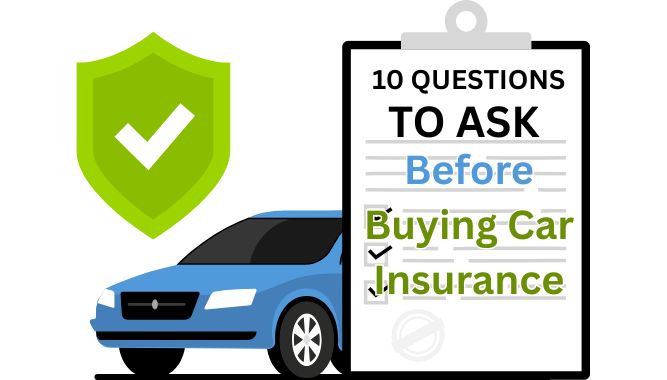Is your car insurance premium eating into your budget?
On average, drivers could save up to $500 per year simply by shopping around for the best rates. Whether you’ve been driving for years or just got your license, saving money on car insurance is a priority for everyone. However, understanding how to lower your premiums without sacrificing coverage can be a bit tricky.
In this article, we’ll show you how to save thousands on car insurance with proven strategies that can reduce your monthly premium, help you find the best rates, and ensure you’re not overpaying for coverage you don’t need. From simple tweaks to your policy to more advanced tricks, we’ve gathered top tips from experts that you can start using today to lower your insurance costs.
01. Understanding What Affects Car Insurance Premiums
Before you start looking for ways to save, it’s important to understand what factors influence your car insurance premium in the first place. By knowing what impacts your rates, you can make smarter decisions about how to adjust your policy and reduce your costs.
1.1: Your Driving History
Insurance companies use your driving history to assess your risk level. If you’ve had speeding tickets or accidents in the past, expect your rates to be higher. On the flip side, a clean driving record can lead to discounts. Tip: Maintain safe driving habits and avoid traffic violations to keep your rates low.
1.2: The Type of Car You Drive
The make and model of your car directly affect your premiums. For example, sports cars or luxury vehicles usually come with higher premiums due to their high repair costs. Opting for safer cars (like sedans or family cars) can significantly reduce your rates. Tip: If you’re buying a new car, consider a model that’s cheaper to insure.
1.3: Your Location
Where you live plays a crucial role in setting your insurance rates. Urban areas with higher traffic are more prone to accidents, so if you live in a city, you may face higher premiums. Tip: Bundling your car insurance with homeowners insurance can help reduce rates, especially in high-risk areas.
2: Tips for Reducing Your Car Insurance Premiums
Now that you understand the key factors influencing your premiums, it’s time to take action. Here are some proven tips to help you lower your monthly insurance costs without sacrificing essential coverage.
2.1: Shop Around for the Best Deals
Don’t settle for your current insurer without comparing other options. You can save hundreds by comparing car insurance quotes from multiple providers. Use online tools like Google Compare or NerdWallet to quickly find the best deals. Tip: Don’t just go for the cheapest quote—make sure to compare coverage options.
2.2: Increase Your Deductible
One of the easiest ways to lower your premium is by increasing your deductible. Raising your deductible (the amount you pay out-of-pocket in the event of an accident) can result in significant savings on your monthly premiums. Tip: Only raise your deductible if you can afford to pay it in case of an accident.
2.3: Take Advantage of Discounts
Most insurance companies offer various discounts that you might not be aware of. These could include:
-
Multi-policy discounts (bundling car and home insurance)
-
Good driver discounts (if you haven’t had any accidents in a set period)
-
Low mileage discounts (for drivers who don’t use their cars frequently)
-
Pay-in-full discounts (paying your premium in one lump sum)
Tip: Always ask your insurer about potential discounts and ensure they’re applied to your policy.
2.4: Improve Your Credit Score
Insurance companies often use your credit score to determine your rates. A higher credit score can lead to lower premiums. If you have a poor score, take steps to improve it—pay off debt, reduce credit card balances, and make timely payments. Tip: A good credit score can save you a lot on your insurance.
2.5: Choose the Right Coverage
While it’s important to have adequate coverage, you may be paying for more than you need. For example, if your car is older or has a low market value, you might not need comprehensive or collision coverage. Tip: Review your policy annually and adjust coverage as necessary, especially if your car’s value decreases.
3: Expert Advice on Negotiating with Insurance
Negotiating with your insurance provider can sometimes feel daunting, but it’s often the key to securing a better deal. Here are some expert tips that can help you negotiate a lower rate, ensuring you get the best value for your coverage.
3.1: Understand Your Policy
Before you negotiate with your insurer, take time to review your current policy. Make sure you understand what’s covered and where you might be over-insured. Tip: If you’re unsure, consult an expert or use online resources to understand your options better.
3.2: Negotiate for a Lower Rate
Insurance agents are often willing to negotiate. Ask about potential discounts, inquire about lowering your rates based on your claims-free history, or even ask if they can match competitors’ quotes. Tip: Don’t be afraid to haggle—a good agent will work with you to find the best rate.
3.3: Consider Local or Smaller Insurers
While big-name insurance companies often dominate, local and smaller providers can sometimes offer more personalized service and lower rates. Tip: Ask around in your community or research regional insurers for better deals.
4: Common Mistakes to Avoid When Shopping for Car Insurance
While finding the right insurance policy is crucial, avoiding common pitfalls is just as important. Here are some mistakes to watch out for to ensure you don’t end up paying more than you need to.
4.1: Relying on Price Alone
It’s tempting to go for the cheapest car insurance, but this can lead to gaps in coverage. Tip: Make sure you compare not just prices, but also the level of coverage each policy offers.
4.2: Not Asking for Discounts
Many people forget to ask for discounts, leaving money on the table. Always ask your insurer about available discounts, especially if you’ve been with them for a while. Tip: Ask for a loyalty discount or multi-vehicle discount if you have more than one car.
4.3: Failing to Review Your Policy Regularly
Your insurance needs change over time. Review your policy annually to ensure it still aligns with your current driving habits and vehicle needs. Tip: Make sure your insurance coverage is updated whenever you make significant life changes (e.g., moving, getting married).
5. Real-Life Examples or Case Studies:
Now that you understand the key factors influencing your premiums, it’s time to take action. Here are some proven tips to help you lower your monthly insurance costs without sacrificing essential coverage.
1: Sarah’s Savings by Shopping Around
Sarah, a 35-year-old driver in a suburban area, had been with the same car insurance company for over 10 years. After a review of her policy, she realized her premium had increased significantly over the years. Sarah decided to use an online comparison tool to shop around. She found that by switching to a different insurer, she could save $400 annually with equivalent coverage. By simply comparing quotes from multiple providers, Sarah was able to secure a better deal, saving her hundreds of dollars each year.
Tip: Always compare rates before renewing your policy. Even loyal customers can benefit from shopping around.
2: John’s Savings from Raising His Deductible
John, a 28-year-old driver with a clean record, decided to take a closer look at his car insurance policy after a price hike. By raising his deductible from $500 to $1,000, he was able to reduce his monthly premium by 20%. Though John knew that he would have to pay more out-of-pocket in the event of a claim, he felt confident that he could cover the higher deductible if needed. Over the course of a year, he saved $240, which he used to fund a road trip with his family.
Tip: If you have a stable financial situation and can afford a higher deductible, this is a quick way to lower your premiums.
3: Emily’s Discount for Low Mileage
Emily, a 40-year-old driver, only used her car a few times a week to run errands and commute short distances. After reviewing her insurance policy, she noticed that her insurer offered a “low-mileage” discount for drivers who used their car less frequently. By providing her insurer with the exact number of miles she drove each year, Emily qualified for a 15% discount. This change reduced her annual premium by $180.
Tip: If you don’t drive often, ask your insurer about low-mileage discounts, which can lead to significant savings.
Conclusion:
Saving money on your car insurance doesn’t have to be a complicated process. By understanding what affects your premiums, shopping around for the best deals, and leveraging available discounts, you can easily reduce your costs. Start by comparing quotes today to see how much you could save!



